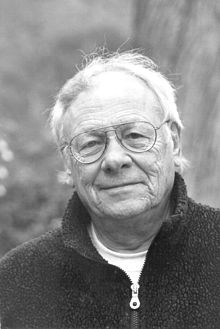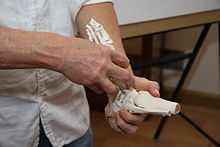Zero balancing
| Zero balancing | |
|---|---|
| Alternative therapy | |
| Benefits | Placebo |
| This article is part of a series on |
| Alternative medicine |
|---|
 |
Zero balancing is a type of manual therapy devised by American osteopathic doctor Frederick "Fritz" Smith in the 1970s. Drawing from principles of osteopathy, Chinese medicine and Structural Integration, Smith proposed that the energy field within the human body could be affected by manual manipulations, so bringing health benefits. The practice teaches that currents of energy are stored within the human skeleton, and that these affect both physical and mental wellbeing.
According to an article in Science-Based Medicine, zero balancing is pseudoscientific.[1] Article writer and lawyer Jann Bellamy places zero balancing among many vitalism-based practices that exist within the "cornucopia of quackery" of massage therapy. Bellamy writes that in the United States of America the public are inadequately protected from such practices because of the lack of independent oversight; instead regulation is carried out within a "closed loop" system by massage-focused organizations.[1]
Description[]
According to Frederick Smith, the founder of zero balancing,[2]
Zero balancing teaches that the deepest currents of energy are in bone, that memory can be held in tissue, that energy fields in the body underlie mind, body and emotions, and that imbalances in the field precede pathology.
The Zero Balancing Health Association say that zero balancing "uses skilled touch to address the relationship between energy and structures of the body".[1]
History[]

Fritz Smith was born in 1929, trained and licensed as an osteopathic physician and surgeon in 1955 and received an M.D. in 1961 in the state of California.[3]
During the late 1960s, Smith studied with several teachers at the Esalen Institute in Northern California, among them Ida Pauline Rolf, founder of Rolfing Structural Integration and J. R. Worsley, founder of the College of Traditional Chinese Acupuncture in London, England. Under Worsley, Smith became the first American to earn the Diploma of Acupuncture at the College of Traditional Chinese Acupuncture in London, in 1972.[3] He also studied with Swami Muktananda, the founder of Siddha Yoga.[4]
Smith began to integrate principles of traditional Chinese medicine with his osteopathic and Structural Integration training. This led him to develop the manual touch therapy system of zero balancing[4] in the early 1970s.[5] The name came about when someone receiving his work described their feeling after the experience as "I feel so well-balanced, like I'm zero; zero-balanced."[6]
Smith is the author of many articles and two books, Inner Bridges: A Guide to Energy Movement and Body Structure and Alchemy of Touch: Moving Towards Mastery Through the Lens of Zero Balancing.[7]
Training[]

Zero Balancing Certification takes about two years. The Zero Balancing Certification Program is a professional continuing education program that provides recognition for high-level skills and experience in working with body structure and energy through touch. Students are required to complete 100 course hours with options to choose one-on-one touch feedback and mentoring activities.[8] The path to learning Zero Balancing includes: class study of information regarding energy and structure, instruction in energetic anatomy and physiology, learning to work directly with energy through touch, and learning the protocol for performing a Zero Balancing session. It also includes giving and receiving Zero Balancing sessions, obtaining feedback from experienced practitioners, and (if in the Certification program) having a personal mentor to help guide one's study. As of 2009 there were about 700 practitioners.[7]
See also[]
References[]
- ^ Jump up to: a b c Bellamy J (17 September 2015). "Massage Therapy rubs me the wrong way". Science-Based Medicine.
- ^ Fritz Frederick Smith quoted at "About Zero Balancing". Zero Balancing Health Association. Retrieved 18 July 2016.
- ^ Jump up to: a b Calvert, Robert; Calvert, Judy (1994). "Interview with Frederick "Fritz" Smith, M.D". Massage Magazine. p. 40.
- ^ Jump up to: a b Smith, Fritz Frederick (1986). Inner Bridges – A Guide to Energy Movement and Body Structure. p. 89. ISBN 0893340863.
- ^ Geggus, Pam (2004). "Introduction to the concepts of Zero Balancing". Journal of Bodywork and Movement Therapies. 8: 58. doi:10.1016/S1360-8592(03)00066-4.
- ^ Beaumont, Richard (1991), "Zero Balancing", Kindred Spirit, p. 27.
- ^ Jump up to: a b Lauterstein, David (May–June 2009). "Reflections, a conversation with Fritz Smith on Zero Balancing". Massage and Bodywork. p. 79.
- ^ https://www.zerobalancing.com/professional_training/certification
Further reading[]
- Ralston, Amy Louise (1998). "Zero balancing: Information on a therapy". Complementary Therapies in Nursing and Midwifery. 4 (2): 47–9. doi:10.1016/S1353-6117(98)80025-5. PMID 10025287.
External links[]
| Wikimedia Commons has media related to Zero Balancing. |
- Alternative medical treatments
- Energy therapies
- Manual therapy
- Massage therapy
- Mind–body interventions
- Pseudoscience